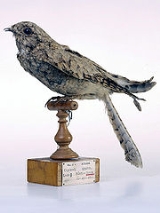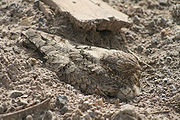
Egyptian Nightjar
Encyclopedia
The Egyptian Nightjar, Caprimulgus aegyptius, is a medium-small nightjar
which occurs in south west Asia
and north Africa
, and winters
in tropical Africa. It is a late migrant, seldom appearing before the end of April or beginning of May. It is a rare visitor to Europe
, but, remarkably, has twice occurred as far away as Great Britain
.
Open desert with a few trees or bushes are the haunts of this crepuscular
nightjar. It flies at dusk, most often at sundown, with an easy, silent moth
-like flight; its strong and deliberate wingbeats alternate with sweeps and wheels with motionless wings.
 The variegated plumage is much paler than the European Nightjar
The variegated plumage is much paler than the European Nightjar
. The adult is sand-colours, barred and streaked with buff and brown. The under parts are sandy or whitish. It is smaller, but relatively longer-winged and longer-tailed than the more widespread species. Like other nightjars, it has a wide gape, long wings, soft downy plumage and nocturnal habits. The male has tiny white wing spots. The length is 25cm, and the wingspan 55cm.
Its call is a repetitive mechanical kroo-kroo-kroo…, which rises and falls as the bird turns its head from side to side. Crepuscular insects, such as moth
s, are its food.
During the day this nightjar lies silent upon the ground, concealed by its plumage; it is difficult to detect, blending in with the sandy soil. No nest is made; the two elongated and elliptical eggs are placed upon the bare ground; the brooding bird, sitting closely, is their best protection.
Nightjar
Nightjars are medium-sized nocturnal or crepuscular birds with long wings, short legs and very short bills. They are sometimes referred to as goatsuckers from the mistaken belief that they suck milk from goats . Some New World species are named as nighthawks...
which occurs in south west Asia
Asia
Asia is the world's largest and most populous continent, located primarily in the eastern and northern hemispheres. It covers 8.7% of the Earth's total surface area and with approximately 3.879 billion people, it hosts 60% of the world's current human population...
and north Africa
Africa
Africa is the world's second largest and second most populous continent, after Asia. At about 30.2 million km² including adjacent islands, it covers 6% of the Earth's total surface area and 20.4% of the total land area...
, and winters
Bird migration
Bird migration is the regular seasonal journey undertaken by many species of birds. Bird movements include those made in response to changes in food availability, habitat or weather. Sometimes, journeys are not termed "true migration" because they are irregular or in only one direction...
in tropical Africa. It is a late migrant, seldom appearing before the end of April or beginning of May. It is a rare visitor to Europe
Europe
Europe is, by convention, one of the world's seven continents. Comprising the westernmost peninsula of Eurasia, Europe is generally 'divided' from Asia to its east by the watershed divides of the Ural and Caucasus Mountains, the Ural River, the Caspian and Black Seas, and the waterways connecting...
, but, remarkably, has twice occurred as far away as Great Britain
Great Britain
Great Britain or Britain is an island situated to the northwest of Continental Europe. It is the ninth largest island in the world, and the largest European island, as well as the largest of the British Isles...
.
Open desert with a few trees or bushes are the haunts of this crepuscular
Crepuscular
Crepuscular animals are those that are active primarily during twilight, that is during dawn and dusk. The word is derived from the Latin word crepusculum, meaning "twilight." Crepuscular is, thus, in contrast with diurnal and nocturnal behavior. Crepuscular animals may also be active on a bright...
nightjar. It flies at dusk, most often at sundown, with an easy, silent moth
Moth
A moth is an insect closely related to the butterfly, both being of the order Lepidoptera. Moths form the majority of this order; there are thought to be 150,000 to 250,000 different species of moth , with thousands of species yet to be described...
-like flight; its strong and deliberate wingbeats alternate with sweeps and wheels with motionless wings.

European Nightjar
The European Nightjar, or just Nightjar, Caprimulgus europaeus, is the only representative of the nightjar family of birds in most of Europe and temperate Asia.- Habitat and distribution :...
. The adult is sand-colours, barred and streaked with buff and brown. The under parts are sandy or whitish. It is smaller, but relatively longer-winged and longer-tailed than the more widespread species. Like other nightjars, it has a wide gape, long wings, soft downy plumage and nocturnal habits. The male has tiny white wing spots. The length is 25cm, and the wingspan 55cm.
Its call is a repetitive mechanical kroo-kroo-kroo…, which rises and falls as the bird turns its head from side to side. Crepuscular insects, such as moth
Moth
A moth is an insect closely related to the butterfly, both being of the order Lepidoptera. Moths form the majority of this order; there are thought to be 150,000 to 250,000 different species of moth , with thousands of species yet to be described...
s, are its food.
During the day this nightjar lies silent upon the ground, concealed by its plumage; it is difficult to detect, blending in with the sandy soil. No nest is made; the two elongated and elliptical eggs are placed upon the bare ground; the brooding bird, sitting closely, is their best protection.

